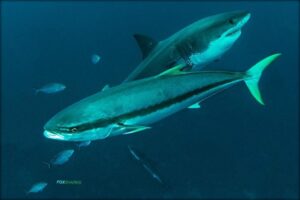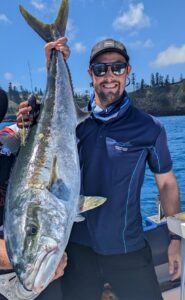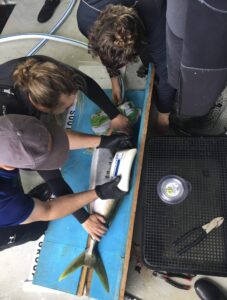
One of South Australia’s most popular game fish, yellowtail kingfish, have become a side attraction for tourists diving with white sharks at Australia’s only cage-diving site.

Researchers from Flinders University’s Southern Shark Ecology Group investigated the effects of the berley and bait (southern bluefin tuna) used to attract white sharks on kingfish activity and body condition.

Yellowtail kingfish (Seriola lalandi) can be regular residents of the Neptune Islands, spending months along side white sharks around cage-diving boats operating near the islands off South Australia’s southern Eyre Peninsula.
Study leader Dr Thomas Clarke, from the College of Science and Engineering, says acoustic transmitters were attached to 18 yellowtail kingfish which were tracked over two years years through an array of acoustic receivers at the Neptune Islands Group Marine Park.
“We found that daily activity of kingfish increased by 15% when food-based attractants such as berley were used, and the frequency of ‘bursting behaviours’ (exceeding 4 m/s2) also increased by 60%,” he says.
“However, despite raised activity and frequency of (fast) burst swimming events, physiological (body) condition of the fish remained similar to healthy kingfish from control sites not exposed to tourism.”

The research concluded that supplemental food sources provided through wildlife tourism – in the case of the South Australian shark tourism industry, southern bluefin tuna which is high in natural proteins and oils – may be sufficient to compensate for the increased energy expenditure and lessen the effects of tourism on individual fitness and health.
The study highlights that the effects of provisioning from wildlife tourism can extend beyond changes in behaviours and movements, and can influence the energetic ‘budgets’ of non-focal animals through increased activity.
“Unfortunately, these non-focal species are often underrepresented in studies assessing effects from wildlife tourism,” Dr Clarke concludes.
Read the article – (2023) by TM Clarke, SK Whitmarsh, C Champion, H Pederson, L Meyer, JD Dennis, RG Dwyer and C Huveneers – published in ICES Journal of Marine Science (Oxford University Press) DOI: 10.1093/icesjms/fsad093.
Acknowledgements: This study used data sourced from Australia’s Integrated Marine Observing System (IMOS) – IMOS is enabled by the ³Ô¹ÏÍøÕ¾ Collaborative Research Infrastructure Strategy (NCRIS). Body condition measurements were assisted by the CSIRO Coasts and Ocean Research team. This study was funded by the Holsworth Wildlife Research Endowment (Project Number 3000010613), and the Biology Society of South Australia (2018 Annual Field Grant).








